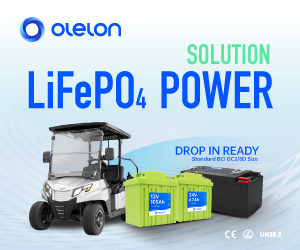For most electric vehicles and equipment that run on deep-cycle flooded lead-acid batteries, routine maintenance can be as simple as charging regularly and replenishing water in the cells as needed. Proper charging, however, is not as simple as plugging in any available charger, as this is not the correct way to optimize the performance and life of these types of batteries.
Manufacturers of deep-cycle batteries recommend using a properly sized charger for the amp-hour capacity of the batteries that also has the proper charge algorithm for the type of batteries being charged.
Most modern electric vehicle chargers use a 3-stage charge algorithm that consists of a bulk charge stage, an absorption charge stage, and the finish charge stage. Some chargers may also have a float charge and an equalization charge setting. Since the batteries should already be fully charged when these settings are used, float and equalization charges are not considered charge stages in a 3-stage charge regime.
Properly sizing the charger to the amp-hour capacity of the batteries is key. To do this, the bulk charge stage should have a charge current of approximately 10% of the 20 hour capacity of the batteries, and the finish charge stage should have a charge current of approximately 3% of the 20 hour capacity of the batteries. Additionally, the voltage output of the charger should be sized to the number of cells connected in series in the battery pack.
For lead-acid batteries, the nominal charger voltage is the number of cells connected in series times 2 volts per cell. For example, a battery pack with 24 cells connected in series should use a 48-volt charger. The charger should also have the capability of providing an on-charge voltage of at least 2.6 volts per cell; so that the same 48-volt charger should be capable of providing at least 62.4 volts on a charge to completely charge a 48-volt battery pack.
The charge algorithm used by the charger determines how the charger applies the 3-stage profile to properly charge the battery pack without significantly overcharging or undercharging over the life of the battery. During the bulk charge stage, a properly sized charger will return approximately 80% of the amp-hours removed on the previous discharge within 4-8 hours depending on how deeply the battery was discharged. During the absorption charge stage, the charge current slowly decreases until 100% of the amp-hours removed on the previous discharge are returned – usually within 1-3 hours.
Even though 100% of the discharged amp-hours have been returned, the battery is not fully charged.
Because of efficiency losses, the battery must be overcharged to reach a full state of charge. The amount of overcharge required is dependent upon many factors such as battery chemistry (FLA, AGM, or GEL), battery temperature, battery type, and manufacturer, and battery age and condition. This is also the primary reason for selecting the proper charge algorithm or charge profile for the battery being charged. The finish charge stage is designed to provide the proper amount of overcharge to fully charge the battery without overheating and potentially damaging the battery. A properly sized charger should be capable of fully charging a discharged battery within 8-12 hours.
Once the battery is fully charged, a float charge setting can be used to maintain the battery at a full charge state by off-setting the normal self-discharge rate. Similarly, an equalization charge setting should be used to periodically provide an additional amount of overcharge to balance the cells connected in series and to provide sufficient gassing to fully mix the electrolyte to prevent electrolyte stratification. The frequency of equalization charging should be based on the application and the frequency and depth of discharges.
As with any electrical device, battery chargers can malfunction or deteriorate over time. It is important to check the battery charger for proper function regularly but, in particular, any time battery performance is observed to be declining. Decreasing battery performance can be caused by a charger that is not performing a proper charge profile. There is a charger diagnostic procedure on the US Battery website that can be used to determine if poor battery performance is caused by underperforming batteries or an underperforming charger.
Taking the appropriate steps to properly charge your lead-acid deep-cycle batteries can also help extend their service life and maintain them in top shape. Following are some additional tips:
- Charge batteries in a well-ventilated area
- Always charge batteries as soon as possible after discharging and charge at every opportunity after use to limit the depth of discharge (DOD) and increase cycle life. US Battery recommends maintaining DOD to 50% or less for optimum life.
- Always use a properly sized charger with the proper charge algorithm for the battery being charged.
- Always fully charge batteries before storing for periods longer than one month.
- Check electrolyte levels monthly and fill batteries with distilled or deionized water to cover the plates before charging but don’t fully top up electrolyte levels until after charging.
- Perform an equalization charge at least once a month to balance the cells connected in series to prevent sulfation and to provide sufficient gassing to fully mix the electrolyte to prevent electrolyte stratification.
Additional information on charger diagnostics, battery maintenance and ways to increase battery efficiency and service life can be found on the U.S. Battery website at www.usbattery.com.

























